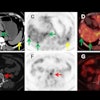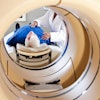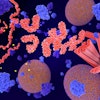CHICAGO - When it comes to sensitivity and accuracy, the radionuclide of choice for imaging pediatric lymphoma is fluorodeoxyglucose (FDG). According to research presented at the RSNA Sunday by a team of investigators from the departments of radiology and pediatrics at the University of Michigan in Ann Arbor, MI, FDG-PET trumps gallium imaging for the management of pediatric patients with lymphoma.
“The purpose of the study was to assess the uptake of FDG in lymphomas presenting in childhood and to determine the potential utility of the technique in comparison with standard imaging modalities,” said Dr. Barry Shulkin, who presented the results of the group’s study.
The team examined the results of 22 patients in 42 scans over a period of ten years. The study group consisted of 13 males and nine females who ranged from 8 to 18 years old, with a median age of 15.5. Half the patients had Hodgkin’s lymphoma, the other half had non-Hodgkin’s lymphoma. The patients underwent FDG-PET imaging, with results compared to 30 gallium scans that were performed within five weeks (most within two weeks, according to Shulkin) of the FDG-PET scan.
“The final diagnosis was based on biopsy, follow-up imaging, or clinical course,” noted Shulkin.
Review of the PET images was performed by two experienced readers blinded to clinical details except for the CT findings. In 10 patients studied at diagnosis before therapy, the gallium, FDG-PET, and CT scans were concordantly positive for disease sites in six of the patients. In nine patients studied during therapy, FDG-PET identified residual disease in four; gallium scans were positive in two, negative in one, and not available in one.
“We found that overall, on a scan-by-scan basis, FDG-PET imaging had a 100% sensitivity. The gallium was less sensitive at 73%. Overall accuracy was about 66% for the gallium and about 80% for the FDG-PET. When we looked just at the patients who underwent initial studies at the time of staging, eight out of 10 had positive gallium scans; whereas 11 out of 11 had positive FDG scans,” said Shulkin.
In six patients studied after completion of therapy who had residual masses on CT scans, FDG-PET detected residual/recurrent disease in two patients while gallium scans were positive in one and negative in one. In one patient in complete remission, the last serial gallium scan showed resolution of thymic rebound at nine months after completion of therapy while the last serial FDG-PET scan still showed thymic uptake, noted Shulkin.
Shulkin shared the outcomes of the study group with the audience: In the 10 patients with at least one negative FDG-PET scan during or after therapy, eight have remained disease free from 1-94 months and one is still receiving therapy.
The researchers believe that FDG-PET scanning is very useful in patients whose gallium studies are negative and in whom residual disease is suspected. Additionally, they feel that FDG-PET scanning may identify those patients with residual masses where the malignancy has been eradicated and doesn’t require further therapy.
However, before gallium scans for staging pediatric lymphoma go the way of the dinosaur, the investigators advocate that more research be done. “Larger trials are clearly required to confirm and validate the findings,” cautioned Shulkin.
By Jonathan S.
Batchelor
AuntMinnie.com staff writer
December 1, 2002
Copyright © 2002 AuntMinnie.com



















